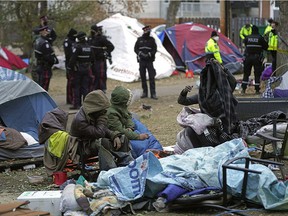
Article content
Though we haven’t had it nearly enough in these parts, it’s sure great to again feel Stanley Cup playoff excitement in Edmonton.
advertisement 2
Article content
Not to put any added pressure on the Oilers, but a spring of celebration would be a major boost not only to Edmonton’s mood, but to its economy as well — complete with flourishing bars and restaurants, full hotels and sprightlier street life.
However, while the party is (hopefully) taking place, the extra crowds heading Downtown, spending time in the Ice District and riding transit means there are likely to be more interactions with houseless Edmontonians.
In fact, for many residents who haven’t spent much time in the core recently, it could a real eye-opening experience to see first hand the scale of the city’s homelessness and drug poisoning crisis.
I raise this question, because as the Oilers march through the playoffs this month, the reduction of temporary shelter spaces from 1,135 to 634 means more and more individuals will be using other spaces for shelter — including encampments and the LRT system.
advertisement 3
Article content
Neither option is a good one, and yet in listening to city news conferences and council debates over the last couple of weeks, I get the sense that nobody is entirely sure how to handle the issue without creating a bunch of new issues.
I’ll start with the transit system, from where we have heard increasing anecdotes about so-called “non-destination riders,” including such of disruptive behavior, people using seats as beds, and open drug use in stations and trains. I witnessed this myself during a recent LRT ride.
In thinking about this, part of me wonders if a certain amount of this is a reality any major city needs to expect. And perhaps a little education would be useful to help transit users navigate it.
At the same time, we have to demand a certain standard of behavior on public transit, otherwise the “public” part of that is at risk. While most non-destination riders are harmless and are only there because they see nowhere else to go, it can sometimes be difficult to tell the difference from someone more dangerous (and unfortunately, we have had too much of that recently).
advertisement 4
Article content
Increased transit ridership is hugely important to a number of city goals — reduced traffic, emissions, costs and sprawl — but people won’t ride if they don’t feel safe. I see no other option right now but to pay the costs of having a larger security presence, not to arrest, harass or ticket vulnerable people, but to deter the real predators, respond to situations of disorder quickly and direct people to appropriate services.
The city is set to increase its complement of security officers and outreach teams, though I do wonder if it’s going to be sufficient.
The encampments are a somewhat different conundrum. To be clear, no matter what the city does, camps are going to happen this summer to a degree we probably haven’t seen before in Edmonton.
advertisement 5
Article content
The dynamics of this are more complex than you might think. Council heard that some camp residents prefer such accommodations over a shelter bed or a bridge housing unit in an old hotel, because the camps offer more freedom and a better community experience.
For others, encampments increase the risk of victimization, including from a criminal element that preys on the homeless population.
Taking down camps is costly, traumatizes people, and doesn’t actually accomplish much because many residents will simply go set up a camp somewhere else. (For context, the city removed 1,765 camps last year and more than 320 already this year).
Leaving the camps alone risks the health and safety of residents, raises the potential for litter and damage to public spaces, and increases conflict with neighbors who have increasingly expressed concerns about fires, needles, noise, overdoses and other hazards.
advertisement 6
Article content
Over the long term, we know more affordable and supportive housing is a big part of any solution. And while more units are set to open this year, the province’s continued invisibility in this area means there will be nowhere near enough, leaving the city scrambling for short-term mitigation.
The situation has prompted some social service advocates and council members to wonder about the possibility of city-sanctioned encampments. Municipal managers are firmly against the idea, telling council they do nothing to prevent other encampments from springing up, and actually require a great deal of funding to manage that is better spent on more permanent solutions.
The city’s preferred strategy is to take down camps when they become “high risk,” and to bolster its response teams in the hopes of diverting people to better housing and/or treatment options (assuming any are available).
advertisement 7
Article content
Short of an unexpected infusion of provincial cash for more temporary shelter spaces and housing, I have to hesitantly agree with the city strategy as the best harm-reduction possibility to manage an unmanageable situation this summer. To me, the drawbacks of sanctioned camps seem to outweigh the advantages, though the idea may need to be reconsidered should the situation take a turn for the worse.
Overarching all this, the city is set to release a bunch of reports any day on reforming community safety in Edmonton, including how to best use funding previously earmarked for police. Hopefully that will provide at least the start of a blueprint for some long-term progress to this crisis, rather than keeping the city in a vicious cycle of only bad options.